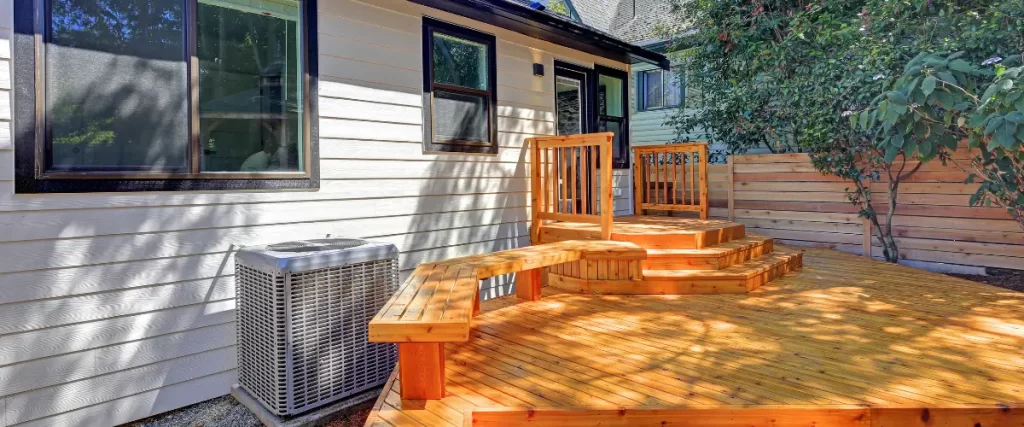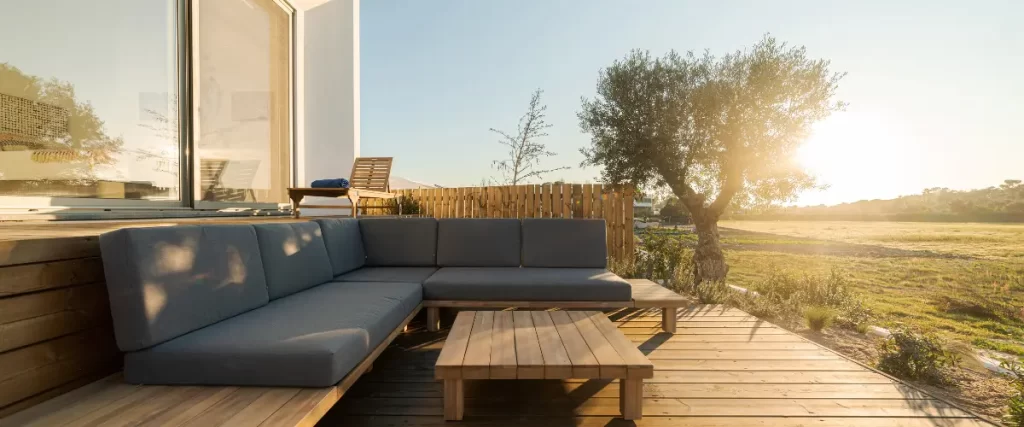If you’ve ever stepped out onto your deck during an Omaha summer and felt like your toes were frying on a skillet, you’re not alone. The relentless sun, wide temperature swings, and unpredictable weather patterns here in eastern Nebraska can do a number on outdoor structures. And if you’re a homeowner planning a new deck—or looking to make the most of the one you’ve got—there’s a good chance you’ve heard that north-facing decks are the way to go.
But why is that, exactly? And more importantly, how can you take full advantage of that orientation to make your deck last longer, look better, and function flawlessly?
Let’s break it all down together.

Omaha’s Harsh Weather Is Tough on Decks
Here in Omaha, we get the full spectrum: scorching hot summers, brutally cold winters, spring hailstorms, and a good dose of humidity year-round. These conditions can seriously stress out your deck.
UV radiation from the south and west exposures fades stains and weakens wood fibers.
Freeze-thaw cycles in winter wreak havoc on decks, especially if moisture gets into cracks.
Storms and wind blow in from the west and southwest, hammering decks with rain and debris.
Humidity can feed mold, mildew, and rot if your deck isn’t well-ventilated or protected.
Because of this, decks that face south or west tend to wear out faster, especially if they aren’t built with premium materials or maintained regularly.
Why North-Facing Decks in Omaha Last Longer
A north-facing deck in Omaha offers some distinct advantages, especially when it comes to longevity and reduced maintenance.
1. Less Direct Sun Exposure
In the Northern Hemisphere, north-facing surfaces receive the least amount of direct sunlight throughout the year. That means less UV damage, less fading, and fewer cracked boards.
2. Lower Heat Stress
With fewer hours of sun exposure, your deck isn’t constantly expanding and contracting with the heat. That means fewer warped boards, looser nails, and popped screws over time.
3. Longer-Lasting Stains and Sealants
Because your deck isn’t baking in the sun, protective finishes tend to last longer, requiring fewer reapplications.
4. Cooler and More Comfortable in Summer
Let’s be real; Omaha summers get hot. A north-facing deck stays shaded most of the day, making it a cooler place to relax, grill, or entertain guests.
How to Optimize Your North-Facing Deck in Omaha
Just because a deck faces north doesn’t mean it’s automatically maintenance-free. Here’s how to get the most life and function out of yours:
1. Choose Durable Materials
Opt for weather-resistant materials like:
Composite decking (low-maintenance and long-lasting)
Pressure-treated wood (cost-effective and durable)
Cedar or redwood (naturally resistant to decay)
PVC decking (ultra low-maintenance)
Each material has its pros and cons, but for Omaha’s weather, durability is key.
2. Proper Drainage and Ventilation
North-facing decks tend to stay shaded, which can cause them to hold moisture longer, especially if airflow is restricted. To prevent mold and rot, make sure to space decking boards properly for air circulation, keep shrubs and landscaping trimmed back, and install skirting vents or leave open gaps underneath.
3. Invest in a Quality Stain or Sealant
Even if your deck doesn’t get a lot of sun, it still needs protection from moisture. Use a high-quality, water-repellent stain or sealant, and reapply every 2–3 years, depending on the product.
4. Keep It Clean
Clean your deck at least twice a year—spring and fall are perfect times. Use a deck cleaner to remove dirt, pollen, and mildew. A light power wash (not too close!) can also help.
5. Add Lighting for Usability
Since your deck won’t get much natural light, especially in the evenings, consider adding recessed post or stair lights, solar-powered railing lights, or motion-sensor sconces to make it safer and more usable after dark.

Omaha Deck Design Tips for North-Facing Spaces
Want to take your north-facing deck to the next level? Here are some ideas:
Add a pergola or roof for extra shade and protection, and choose lighter colors for decking and furniture to reflect light and brighten the space. Incorporate built-in seating or planters for a cozy, integrated look, and consider installing ceiling fans or misting systems to keep cool on humid days.
Place grills or cooking areas strategically to prevent smoke or heat from accumulating near your home.
Local Codes and Considerations in Omaha
If you’re building or modifying a deck in Omaha, make sure to check in with local zoning regulations and building codes. You can find deck construction requirements on the City of Omaha Planning Department website.
Most decks require a permit, especially if they’re more than 30 inches off the ground or attached to your home. Inspections may be required at various stages of construction, so it’s smart to loop in the city early.
Best Decking Manufacturers for Omaha Homes
Top-Rated Decking Brands You Can Trust in Nebraska’s Climate
These brands are known for high durability and long-term performance in extreme Midwestern weather:
Trex – Composite boards with excellent resistance to fading and moisture.
TimberTech – Known for its premium look and low-maintenance materials.
Fiberon – Eco-friendly composite options with durable finishes.
AZEK (by TimberTech) – Offers PVC decking for maximum resistance to rot and insects.
Deckorators – Known for strong warranties and stylish product lines.
FAQ – North-Facing Decks in Omaha
Are north-facing decks too shady in the winter?
Yes, they can feel chilly in the winter. But since most people don’t use their decks much during the colder months, it’s rarely an issue.
Will my deck grow more mildew if it’s north-facing?
It’s possible, especially if airflow is poor. Keep it clean and make sure there’s good drainage and ventilation.
Is a north-facing deck still good for gardening or planters?
Yes—just pick shade-tolerant plants like hostas, ferns, or begonias. You’ll still get indirect light.
Do I need a permit to build or modify my deck in Omaha?
In most cases, yes. Visit Omaha’s permit portal to get started or learn more.
How much longer does a north-facing deck last compared to a south-facing one?
It depends on materials and maintenance, but many north-facing decks show noticeably less wear after 5–10 years.

Ready to Make the Most of Your Omaha Deck?
If you already have a north-facing deck, you’re ahead of the game. But there’s still a lot you can do to make it last longer, look better, and function the way you want.
If you’re building from scratch, now’s the time to think smart—and north-facing just might be your best bet.
Need expert guidance on decking materials, layout ideas, or local building codes? Contact us at (402) 369-5724 and let’s talk through your deck building project. We’re happy to help you build a deck that’s built to last right here in Omaha.
